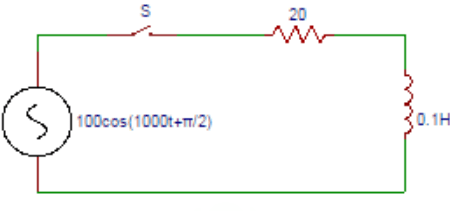This set of Network Theory Multiple Choice Questions & Answers (MCQs) focuses on “Sinusoidal Response of an R-L Circuit”.
1. In the sinusoidal response of R-L circuit, the complementary function of the solution of i is?
a) ic = ce-t(R/L)
b) ic = cet(RL)
c) ic = ce-t(RL)
d) ic = cet(R/L)
View Answer
Explanation: From the R-L circuit, we get the characteristic equation as (D+R/L)i=V/L cos(ωt+θ). The complementary function of the solution i is ic = ce-t(R/L).
2. The particular current obtained from the solution of i in the sinusoidal response of R-L circuit is?
a) ip = V/√(R2+(ωL)2) cos(ωt+θ+tan-1(ωL/R))
b) ip = V/√(R2+(ωL)2) cos(ωt+θ-tan-1(ωL/R))
c) ip = V/√(R2+(ωL)2) cos(ωt-θ+tan-1(ωL/R))
d) ip = V/√(R2+(ωL)2) cos(ωt-θ+tan-1(ωL/R))
View Answer
Explanation: The characteristic equation consists of two parts, viz. complementary function and particular integral. The particular integral is ip = V/√(R2+(ωL)2) cos(ωt+θ-tan-1(ωL/R)).
3. The value of ‘c’ in complementary function of ‘i’ is?
a) c = -V/√(R2+(ωL)2) cos(θ+tan-1(ωL/R))
b) c = -V/√(R2+(ωL)2) cos(θ-tan-1(ωL/R))
c) c = V/√(R2+(ωL)2) cos(θ+tan-1(ωL/R))
d) c = V/√(R2+(ωL)2) cos(θ-tan-1(ωL/R))
View Answer
Explanation: Since the inductor does not allow sudden changes in currents, at t = 0, i = 0. So, c = -V/√(R2+(ωL)2) cos(θ-tan-1(ωL/R)).
4. The complete solution of the current in the sinusoidal response of R-L circuit is?
a) i = e-t(R/L)[V/√(R2+(ωL)2) cos(θ-tan-1)(ωL/R))]+V/√(R2+(ωL)2) cos(ωt+θ-tan-1)(ωL/R))
b) i = e-t(R/L)[-V/√(R2+(ωL)2) cos(θ-tan-1)(ωL/R))]-V/√(R2+(ωL)2) cos(ωt+θ-tan-1)(ωL/R))
c) i = e-t(R/L)[V/√(R2+(ωL)2) cos(θ-tan-1)(ωL/R))]-V/√(R2+(ωL)2) cos(ωt+θ-tan-1)(ωL/R))
d) i = e-t(R/L)[-V/√(R2+(ωL)2) cos(θ-tan-1)(ωL/R))]+V/√(R2+(ωL)2) cos(ωt+θ-tan-1)(ωL/R))
View Answer
Explanation: The complete solution for the current becomes i = e-t(R/L)[-V/√(R2+(ωL)2) cos(θ-tan-1)(ωL/R))]+V/√(R2+(ωL)2)cos(ωt+θ-tan-1)(ωL/R)).
5. In the circuit shown below, the switch is closed at t = 0, applied voltage is v (t) = 100cos (103t+π/2), resistance R = 20Ω and inductance L = 0.1H. The complementary function of the solution of ‘i’ is?

a) ic = ce-100t
b) ic = ce100t
c) ic = ce-200t
d) ic = ce200t
View Answer
Explanation: By applying Kirchhoff’s voltage law to the circuit, we have 20i+0.1di/dt=100cos(103 t+π/2) => (D+200)i=1000cos(1000t+π/2). The complementary function is ic = ce-200t.
6. In the circuit shown below, the switch is closed at t = 0, applied voltage is v (t) = 100cos (103t+π/2), resistance R = 20Ω and inductance L = 0.1H. The particular integral of the solution of ‘ip’ is?

a) ip = 0.98cos(1000t+π/2-78.6o)
b) ip = 0.98cos(1000t-π/2-78.6o)
c) ip = 0.98cos(1000t-π/2+78.6o)
d) ip = 0.98cos(1000t+π/2+78.6o)
View Answer
Explanation: Assuming particular integral as ip = A cos (ωt + θ) + B sin(ωt + θ). We get ip = V/√(R2+(ωL)2) cos(ωt+θ-tan-1(ωL/R)) where ω = 1000 rad/sec, V = 100V, θ = π/2, L = 0.1H, R = 20Ω. On substituting, we get ip = 0.98cos(1000t+π/2-78.6o).
7. In the circuit shown below, the switch is closed at t = 0, applied voltage is v (t) = 100cos (103t+π/2), resistance R = 20Ω and inductance L = 0.1H. The complete solution of ‘i’ is?

a) i = ce-200t + 0.98cos(1000t-π/2-78.6o)
b) i = ce-200t + 0.98cos(1000t+π/2-78.6o)
c) i = ce-200t + 0.98cos(1000t+π/2+78.6o)
d) i = ce-200t + 0.98cos(1000t-π/2+78.6o)
View Answer
Explanation: The complete solution for the current is the sum of the complementary function and the particular integral. The complete solution for the current becomes i = ce-200t + 0.98cos(1000t+π/2-78.6o).
8. The current flowing through the circuit at t = 0 in the circuit shown below is?

a) 1
b) 2
c) 3
d) 0
View Answer
Explanation: At t = 0 that is initially the current flowing through the circuit is zero that is i = 0. So, i = 0.
9. In the circuit shown below, the switch is closed at t = 0, applied voltage is v (t) = 100cos (103t+π/2), resistance R = 20Ω and inductance L = 0.1H. The value of c in the complementary function of ‘i’ is?

a) c = -0.98cos(π/2-78.6o)
b) c = -0.98cos(π/2+78.6o)
c) c = 0.98cos(π/2+78.6o)
d) c = 0.98cos(π/2-78.6o)
View Answer
Explanation: At t = 0, the current flowing through the circuit is zero. Placing i = 0 in the current equation we get c = -0.98cos(π/2-78.6o).
10. In the circuit shown below, the switch is closed at t = 0, applied voltage is v (t) = 100cos (103t+π/2), resistance R = 20Ω and inductance L = 0.1H. The complete solution of ‘i’ is?

a) i = [-0.98 cos(π/2-78.6o)] exp(-200t)+0.98cos(1000t+π/2-78.6o)
b) i = [-0.98 cos(π/2-78.6o)] exp(-200t)-0.98cos(1000t+π/2-78.6o)
c) i = [0.98 cos(π/2-78.6o)] exp(-200t)-0.98cos(1000t+π/2-78.6o)
d) i = [0.98 cos(π/2-78.6o)] exp(-200t)+0.98cos(1000t+π/2-78.6o)
View Answer
Explanation: The complete solution for the current is the sum of the complementary function and the particular integral.
So, i = [-0.98 cos(π/2-78.6o)] exp(-200t)+0.98cos(1000t+π/2-78.6o).
Sanfoundry Global Education & Learning Series – Network Theory.
To practice all areas of Network Theory, here is complete set of 1000+ Multiple Choice Questions and Answers.
If you find a mistake in question / option / answer, kindly take a screenshot and email to [email protected]
